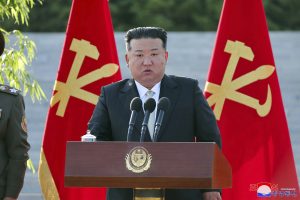While North Korea’s nuclear and missile program is seen as a threat in Japan and South Korea, for its part, Pyongyang considers the United States, Japan, and South Korea to be the greater threat. Not only are the world’s first, fourth, and 14th largest economies working closely together on security to put pressure on Pyongyang, but South Korea aspires to unify the peninsula by absorbing the north, while the United States has in recent decades attacked Afghanistan, Iraq, and Libya, resulting in regime change in each country. As a dictatorship with clear anti-American tendencies, North Korea feels it has no choice but to brace itself.
An arms race is underway in Northeast Asia, and as North Korean leader Kim Jong Un has said many times, it looks like “a new Cold War.” The year 2018, when the first-ever U.S.-North Korea summit was held in Singapore and three inter-Korean summits took place, now seems like a long time ago, but the switch from conciliation to confrontation still feels like déjà vu. The U.S., Japan, South Korea, and North Korea have a long history of finally reaching an agreement through diplomatic negotiations, only to be unable to implement it.
The first U.S. president to seriously consider an attack on North Korea was Bill Clinton, who faced the first nuclear crisis in the early 1990s. However, the Pentagon estimated that if war broke out again on the Korean Peninsula, 52,000 U.S. and 490,000 South Korean military personnel would be killed or wounded in the first 90 days. In October 1994, the Agreed Framework between the United States of America and the Democratic People’s Republic of Korea was signed so that the United States took on the responsibility of providing light-water nuclear power reactors in exchange for North Korea freezing its graphite-moderated reactors. Subsequently, an agreement was reached in the U.S.-North Korea missile talks, with Clinton even considering a normalization of relations with North Korea toward the end of his administration.
However, his successor George W. Bush intensified the rift when he included North Korea in an “axis of evil” together with Iran and Iraq, and accused it of developing uranium-enriched nuclear weapons. Although a diplomatic solution was ultimately sought for this second nuclear crisis as well, this time the Bush administration involved China, having realized that it would be difficult to get North Korea to implement any bilateral agreement between the United States and North Korea. In April 2003, the United States, North Korea, and China held talks. In addition to South Korea, which felt that this issue very much concerned them, other countries to announce their participation were Japan, which was focused on the abduction issue, and even Russia.
The so-called Six-Party Talks began in August the same year. Although a joint statement was adopted in September 2005 so that an agreement between the United States and North Korea was endorsed by the other four countries, the content comprised the same elements as that promised in the Agreed Framework, albeit with some differences in wording.
Although an agreement on “denuclearization” was finally reached, the United States had no choice but to confront North Korea with another accusation, this time involving counterfeit U.S. dollar bills, and so the Kim Jong Il regime conducted its first nuclear test in October 2006. U.S. President Barack Obama, who took office in January 2009, called for “strategic patience,” a policy of ignoring North Korea, which ultimately gave Pyongyang the time to develop its weapons.
Obama’s successor, Donald Trump, boasted that military action against North Korea was an option, taking tensions to a new level, but his mercurial character also facilitated the U.S.-North Korea summit in June 2018. In fact, one would have thought that if implementation is impossible despite agreement among the high-ranking officials of six countries, then direct negotiations between the leaders would be the natural next step. A quarter of a century having passed since the Agreed Framework, it seemed that progress was being made toward denuclearization, learning the lessons from past failures.
However, the summit in Singapore never produced a joint statement. You could say that this was a result of both sides pressuring the other party too much to make concessions at the implementation stage. The lesson learned from the three agreements and the three failures is that confidence-building mechanisms are needed in relations among countries that have for years been mired in extreme mutual distrust, while the goal should be an agreement that can actually be implemented. It took 30 years to learn this lesson, representing decades of repeated agreements and failed implementations not only in U.S.-North Korea negotiations but also in Japan-North Korea and inter-Korean relations.
Regardless of who wins this year’s U.S. presidential election, Washington should not allow North Korea’s military buildup to go unchecked. Administrations under both Biden and Trump have already argued that “disarmament negotiations” should be held instead of “denuclearization negotiations,” something that would be difficult to implement even if an agreement could be reached.
The gap between the United States, which is seeking more realistic solutions, and Japan and South Korea, which perceive North Korea as a constant threat, can only widen. In particular, the Japanese government, which has maintained a hardline stance toward North Korea, will be forced to make an exceedingly difficult decision on whether to insist on “complete denuclearization,” the implementation of which has failed repeatedly despite agreements, or to tacitly approve of the “disarmament negotiations” of the United States.

































